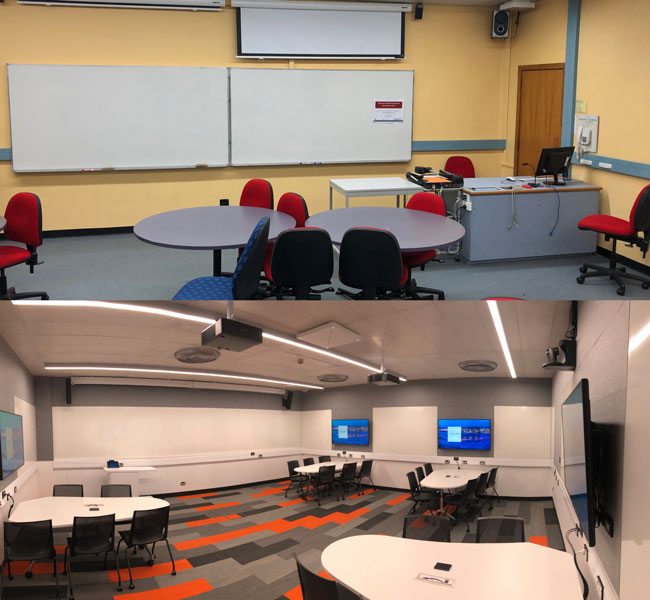Thursday 3 June 2021 11:36am

The Burns 3 Lecture Theatre – (top) before its make-over and (below) after.
Most students believe teaching spaces revamped on the Dunedin campus to include the latest technology and furniture are helping their learning – and now more lecturers and tutors are being sought for those pilot spaces next semester.
Of the 113 students who responded to an initial survey, 101 agreed or strongly agreed the pilot spaces will benefit their learning during a tutorial, lecture, or seminar – and 74 per cent agreed or strongly agreed the pilot spaces are the type of rooms students expect a university to provide, University of Otago Strategic Architect Gordon Roy says.
Both students and staff who answered the survey mention how easily students can collaborate on group work in the pilot spaces, which create a more informal, personal, and social environment.
The pilot teaching spaces are in St David Lecture Theatre Room G04, Burns 3, University of Otago College of Education Gymnasium Seminar Room, and Castle D.
The pilot rooms have been created to reflect changing teaching approaches, by providing spaces that can meet current and future learning and teaching needs. The spaces include new audio-visual equipment, group-oriented pods of mobile desks and chairs, writable wall surfaces, a smaller lectern and more circulation space for tutors to move around in, LED lighting, acoustic panelling, new decorative features, and new carpet.
All the rooms are enabled for Zoom video conferencing so remote students can interact with the sessions. Technology upgrades include an audio system with multiple microphones around the room as well.
The aim is to support a variety of approaches to learning and teaching for between 24 and 40 students, Mr Roy says.
While each of the rooms has been configured slightly differently to test different set-ups, students particularly like having two large screens on both sides of the room to easily see presentations and TV screens on group tables, multiple whiteboards groups can use during discussions, and all the rooms being modern, light, colourful, and comfortable.
Some students also say they find interacting with the lecturer easier and speaking in lectures less intimidating: “The overall vibe is amazing”; “I love it”; “absolutely love it, good job!” and “very cool!”
Some tutors and lecturers say, in the survey, the furniture lay-out suits their style better than rows of desks, and some say they will be including more group work in their teaching.
While some people have changed their teaching materials, others have not changed either their materials or their teaching style, Mr Roy says.
Feedback from staff and students was not as positive about early technology teething problems but many of those have now been resolved.
Some students’ suggestions for improvements include more power plugs (Castle D), tables students can write on (whiteboard tables), rubbish bins and bean bags.
Some tutors’ and lecturers’ suggestions for improvements include headphones for students at group desks and more adapters for the technology.
One tutor believes the pilots could spark some interesting developments in connectivity between in-person tutorials and distance students using Zoom video conferencing. One person wanted larger rooms to be revamped as well, Mr Roy says.
The project team is running focus groups at the end of each semester to get more qualitative data about the spaces. Office of Student Success research fellow Dr Rebecca Bird is assisting the project team with gathering and processing all the data from the pilot – including three surveys of staff and students each semester.
This pilot project will contribute significantly to understanding what is important to staff and students, to help with planning next year for the University’s learning and teaching spaces for the future.
Now the pilot has been rolled out, the project is seeking more lecturers and tutors to join the pilot for the rest of the year, to test options and find the best fit for our existing and future needs.
Training will be provided and all that is needed in return is for lecturers, tutors, and students to provide feedback on the pilot spaces throughout the year to inform future learning and teaching spaces.
To join the pilot and to discuss your involvement, please contact:
The Timetables Team
Email timetables@otago.ac.nz
Limited spaces are available so please get in touch early.
The pilot learning and teaching spaces have been created by the Campus Development Division and IT Support Services. They are part of the Operations Group which has three top priorities:
Enable – the University to achieve its visions and mission
Engage – with our students, each other, our customers and externally
Experience – of our students, our customers, and externally to be outstanding
